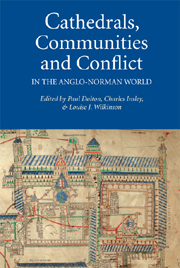Book contents
- Frontmatter
- Contents
- List of Illustrations
- List of Contributors
- Preface
- List of Abbreviations
- Introduction
- 1 The Dangers of Invention: The Sack of Canterbury, 1011, and the ‘theft’ of Dunstan's Relics
- 2 Remembering Communities Past: Exeter Cathedral in the Eleventh Century
- 3 Communities, Conflict and Episcopal Policy in the Diocese of Lichfield, 1050–1150
- 4 The Acta archiepiscoporum Rotomagensium and Urban Ecclesiastical Rivalry in Eleventh-Century Rouen
- 5 Cathedrals and the Cult of Saints in Eleventh-and twelfth-Century Wales
- 6 A Bishop and His Conflicts: Philip of Bayeux (1142–63)
- 7 Ecclesiastical Responses to War in king Stephen's Reign: The Communities of Selby Abbey, Pontefract Priory and York Cathedral
- 8 Secular Cathedrals and the Anglo-Norman Aristocracy
- 9 The Lives of Thomas Becket and the Church of Canterbury
- 10 Caught in the Cross-Fire: Patronage and Institutional Politics in Late twelfth-Century Canterbury
- 11 Crown, Cathedral and Conflict: King John and Canterbury
- 12 The English Monasteries and their French Possessions
- Index of People and Places
- Other Volumes in Studies in the History of Medieval Religion
8 - Secular Cathedrals and the Anglo-Norman Aristocracy
Published online by Cambridge University Press: 12 September 2012
- Frontmatter
- Contents
- List of Illustrations
- List of Contributors
- Preface
- List of Abbreviations
- Introduction
- 1 The Dangers of Invention: The Sack of Canterbury, 1011, and the ‘theft’ of Dunstan's Relics
- 2 Remembering Communities Past: Exeter Cathedral in the Eleventh Century
- 3 Communities, Conflict and Episcopal Policy in the Diocese of Lichfield, 1050–1150
- 4 The Acta archiepiscoporum Rotomagensium and Urban Ecclesiastical Rivalry in Eleventh-Century Rouen
- 5 Cathedrals and the Cult of Saints in Eleventh-and twelfth-Century Wales
- 6 A Bishop and His Conflicts: Philip of Bayeux (1142–63)
- 7 Ecclesiastical Responses to War in king Stephen's Reign: The Communities of Selby Abbey, Pontefract Priory and York Cathedral
- 8 Secular Cathedrals and the Anglo-Norman Aristocracy
- 9 The Lives of Thomas Becket and the Church of Canterbury
- 10 Caught in the Cross-Fire: Patronage and Institutional Politics in Late twelfth-Century Canterbury
- 11 Crown, Cathedral and Conflict: King John and Canterbury
- 12 The English Monasteries and their French Possessions
- Index of People and Places
- Other Volumes in Studies in the History of Medieval Religion
Summary
Much has been written about relations between monasteries (including monastic cathedrals) and the Anglo-Norman aristocracy, and their importance not just in religious life, but also in the development of baronial political and social networks. Cathedrals' roles as parish churches and their relationships with urban elites have also received some attention, but, with the exception of Dr Julia Barrow's work on canons' social backgrounds, little has been written about the nine secular cathedrals and the Anglo-Norman aristocracy. There can, of course, be no question that aristocratic piety focused on monasteries, but the secular cathedral's status as the mother church of the diocese, its chapter's lands, rights, and wealth, and its connection with the bishop must have given it some significance. This paper explores aspects of three elements of the relationship between the secular cathedrals and the aristocracy: benefactions, chapter and prebends, and the cathedral space.
It is commonplace that English secular cathedrals could be semi-public and political meeting places, venues for legal activity, and providers of hospitality, but much of the evidence cited is from the thirteenth century or later. Anglo-Norman evidence is limited, and sometimes negative. Obituary and fraternity lists contain few aristocratic entries compared with those from monasteries. Urban monasteries in cathedral cities often received more baronial patronage. Burial disputes show that when some cathedrals claimed burial rights over barons who died in their cities, the barons, with royal support, preferred monasteries of their own choice. Even at lower levels of baronial society, local lords made their small donations to monasteries.
- Type
- Chapter
- Information
- Cathedrals, Communities and Conflict in the Anglo-Norman World , pp. 151 - 168Publisher: Boydell & BrewerPrint publication year: 2011



